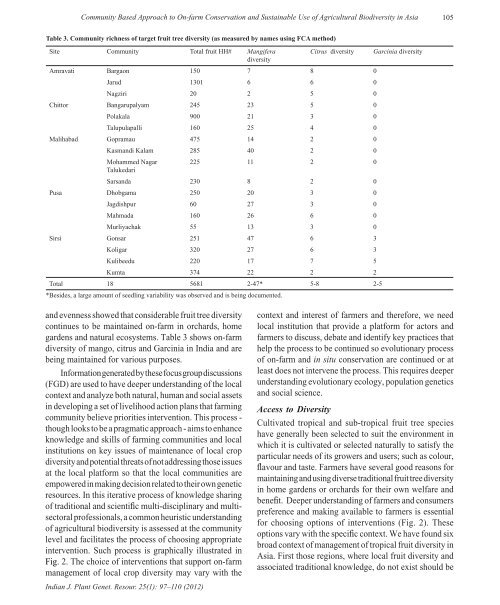indian society of plant genetic resources - Bioversity International
indian society of plant genetic resources - Bioversity International
indian society of plant genetic resources - Bioversity International
You also want an ePaper? Increase the reach of your titles
YUMPU automatically turns print PDFs into web optimized ePapers that Google loves.
Community Based Approach to On-farm Conservation and Sustainable Use <strong>of</strong> Agricultural Biodiversity in Asia 105<br />
Table 3. Community richness <strong>of</strong> target fruit tree diversity (as measured by names using FCA method)<br />
Site Community Total fruit HH# Mangifera<br />
diversity<br />
Citrus diversity Garcinia diversity<br />
Amravati Bargaon 150 7 8 0<br />
Jarud 1301 6 6 0<br />
Nagziri 20 2 5 0<br />
Chittor Bangarupalyam 245 23 5 0<br />
Polakala 900 21 3 0<br />
Talupulapalli 160 25 4 0<br />
Malihabad Gopramau 475 14 2 0<br />
Kasmandi Kalam 285 40 2 0<br />
Mohammed Nagar<br />
Talukedari<br />
225 11 2 0<br />
Sarsanda 230 8 2 0<br />
Pusa Dhobgama 250 20 3 0<br />
Jagdishpur 60 27 3 0<br />
Mahmada 160 26 6 0<br />
Murliyachak 55 13 3 0<br />
Sirsi Gonsar 251 47 6 3<br />
Koligar 320 27 6 3<br />
Kulibeedu 220 17 7 5<br />
Kumta 374 22 2 2<br />
Total 18 5681 2-47* 5-8 2-5<br />
*Besides, a large amount <strong>of</strong> seedling variability was observed and is being documented.<br />
and evenness showed that considerable fruit tree diversity<br />
continues to be maintained on-farm in orchards, home<br />
gardens and natural ecosystems. Table 3 shows on-farm<br />
diversity <strong>of</strong> mango, citrus and Garcinia in India and are<br />
being maintained for various purposes.<br />
Information generated by these focus group discussions<br />
(FGD) are used to have deeper understanding <strong>of</strong> the local<br />
context and analyze both natural, human and social assets<br />
in developing a set <strong>of</strong> livelihood action plans that farming<br />
community believe priorities intervention. This process -<br />
though looks to be a pragmatic approach - aims to enhance<br />
knowledge and skills <strong>of</strong> farming communities and local<br />
institutions on key issues <strong>of</strong> maintenance <strong>of</strong> local crop<br />
diversity and potential threats <strong>of</strong> not addressing those issues<br />
at the local platform so that the local communities are<br />
empowered in making decision related to their own <strong>genetic</strong><br />
<strong>resources</strong>. In this iterative process <strong>of</strong> knowledge sharing<br />
<strong>of</strong> traditional and scientifi c multi-disciplinary and multisectoral<br />
pr<strong>of</strong>essionals, a common heuristic understanding<br />
<strong>of</strong> agricultural biodiversity is assessed at the community<br />
level and facilitates the process <strong>of</strong> choosing appropriate<br />
intervention. Such process is graphically illustrated in<br />
Fig. 2. The choice <strong>of</strong> interventions that support on-farm<br />
management <strong>of</strong> local crop diversity may vary with the<br />
Indian J. Plant Genet. Resour. 25(1): 97–110 (2012)<br />
context and interest <strong>of</strong> farmers and therefore, we need<br />
local institution that provide a platform for actors and<br />
farmers to discuss, debate and identify key practices that<br />
help the process to be continued so evolutionary process<br />
<strong>of</strong> on-farm and in situ conservation are continued or at<br />
least does not intervene the process. This requires deeper<br />
understanding evolutionary ecology, population <strong>genetic</strong>s<br />
and social science.<br />
Access to Diversity<br />
Cultivated tropical and sub-tropical fruit tree species<br />
have generally been selected to suit the environment in<br />
which it is cultivated or selected naturally to satisfy the<br />
particular needs <strong>of</strong> its growers and users; such as colour,<br />
fl avour and taste. Farmers have several good reasons for<br />
maintaining and using diverse traditional fruit tree diversity<br />
in home gardens or orchards for their own welfare and<br />
benefi t. Deeper understanding <strong>of</strong> farmers and consumers<br />
preference and making available to farmers is essential<br />
for choosing options <strong>of</strong> interventions (Fig. 2). These<br />
options vary with the specifi c context. We have found six<br />
broad context <strong>of</strong> management <strong>of</strong> tropical fruit diversity in<br />
Asia. First those regions, where local fruit diversity and<br />
associated traditional knowledge, do not exist should be

















